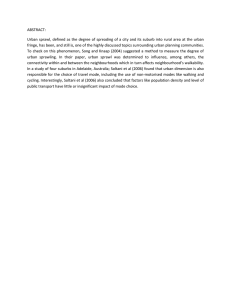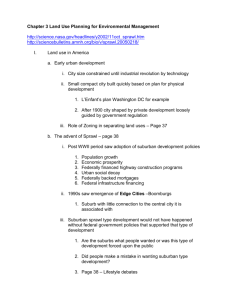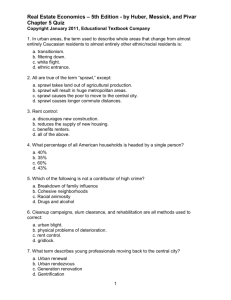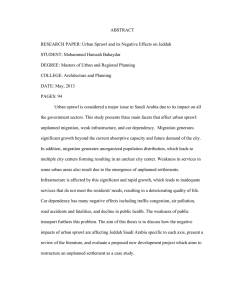Exclusion, separation, creativity, and social capital
advertisement
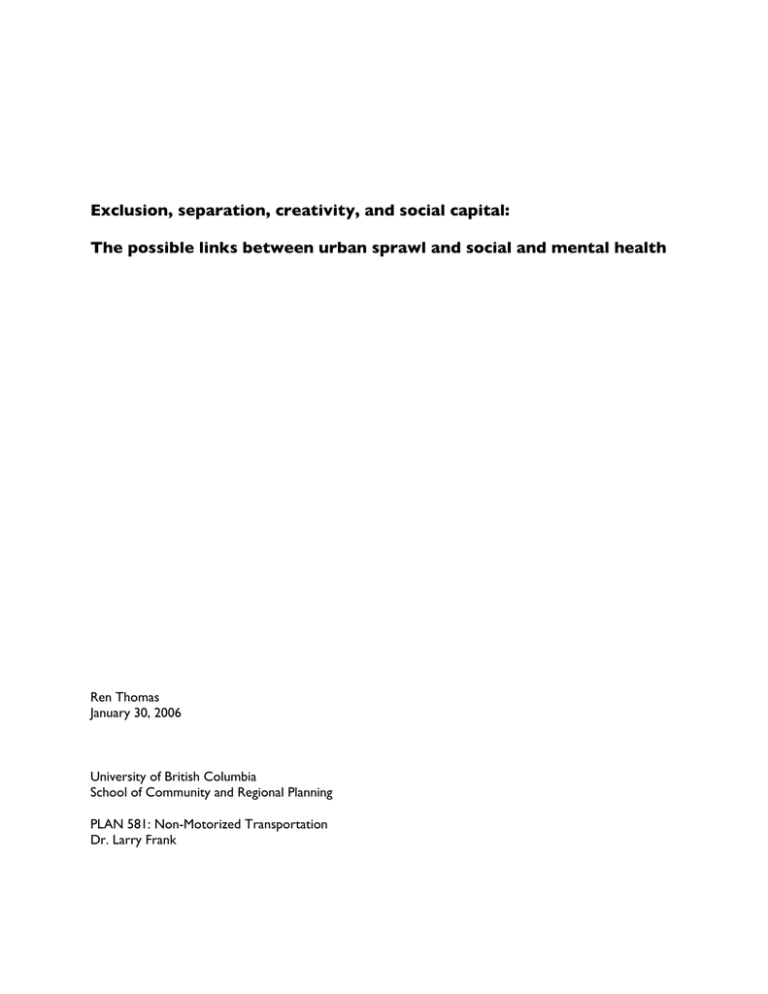
Exclusion, separation, creativity, and social capital: The possible links between urban sprawl and social and mental health Ren Thomas January 30, 2006 University of British Columbia School of Community and Regional Planning PLAN 581: Non-Motorized Transportation Dr. Larry Frank In the past decade, the debate about urban sprawl and its impacts on human life has become broader. Researchers have been concerned with a variety of issues including the environmental impacts of land use separation and increased car travel, the effects of sprawl on chronic diseases, and more recently, the effects of sprawl on our social and mental health. With increasing media coverage of the research showing connections between sprawl and increased incidences of obesity, diabetes, and respiratory illnesses, little has been mentioned about the perhaps subtler effects of urban sprawl on our social and mental health. Few researchers have delved into the possible connections between sprawl and mental illness, with the notable exception of the field of transportation ecology, the study of psychological effects of driving. Other researchers have been studying social networks and social capital in communities. This paper aims to identify common themes and trends in the research on urban sprawl and social and mental health, as well as gaps in our understanding that would provide fertile ground for further research. An exploration of the origins of sprawl helps provide a framework. We can then consider the separation of physical activity from everyday life, the role that walking may play in creativity, and the impact of sprawl on the social capital of communities. Separating the city At the heart of the sprawl debate is the separation of human life into separate parts: family life, professional life, social life, leisure life. Most researchers agree on the characteristics of sprawl, regardless of which side of the sprawl debate they favour. Physical separation of towns and cities into low-density single-use residential areas, employment areas, and public open spaces is one identifying characteristic of sprawl. The connection of these distinct areas by highways and arterials is another. The decreased use of alternative modes of transportation, such as walking, cycling, and public transit reflects a decrease in small-scale connectivity. This Corbusian ideal of separation of uses may be seen as simply physical; from this ideological framework springs most of our current research on travel behaviour. The methodology of this research is based on the assumption that the physical organization of cities informs travel patterns; thus, the separation of land uses results in longer travel distances, so that there is less reliance on non-motorized travel and greater reliance on the automobile. We must also acknowledge that the physical separation of uses seen in sprawling communities also has its roots in mental separation: of home life from professional life, of men from women, of white from non-white, of upper class from lower class. This methodology will allow us to address the impact of urban sprawl on social and mental health. While they are linked to physical separation, they are inseparable from social exclusion. Richard Sennett, in The Uses of Disorder (1970) wrote of the social exclusion implied in suburban life: “Here the images of communal solidarity are forged in order that men can avoid dealing with each another.” (p34) Sennett believed that in suburban communities, people draw a picture of who they are that binds them all together, with a definite set of desires, dislikes and goals, that is not based on shared experiences (p36). He writes, “The “we” feeling, which expresses a desire to be similar, is a way for men to avoid the necessity of looking deeper into each other; instead, men imagine that they know all about each other.” (p39) Because individuals in the community achieve a coherent sense of themselves precisely by avoiding painful experiences and disordered confrontations in creating their own identity, they have little tolerance for other points of view that might jeopardize their entire identity (p44). Sennett believed that in suburban life, the nuclear family had become the basic unit of human life, and that the interactions that occurred in the family were believed to be a microcosm of all the kinds of interaction that exist in the social world at large (p65). As such, families would attempt to suppress divergence and separateness for the sake of order in the family (p65) and the creation of social ties outside of the family unit would be seen as potentially weakening the strength of the family bond (p71). Many feminist writers have discussed the implications of this increased focus on the family unit, and its physical planning complement, suburban sprawl, on the lives of women. Dolores Hayden writes about the backlash towards women’s social planning groups in the 1950s and how separate, isolated suburban homes may have been designed in part to prevent women from organizing towards social reform, as they had done since the 1860s. The material feminists of the Victorian and post-Victorian era had been advocates of more communal living and working conditions for women. Some examples include shared housing for single women and laundry and dining co-ops to ease the strain of household labour on women. Women were also advocates of safe, respectable housing and food preparation for single women and working mothers. But 1950s policy and advertising specifically targeted women, convincing them that modern labour-saving devices could allow them to do all their own housekeeping within their own houses. This enforced the policies of the Federal Housing Administration and mortgage lenders at the time, encouraging families to have their own individual homes, rather than share communal space and housekeeping with others (Hayden, 1982). The home came to be regarded as women’s sphere, morally superior and separate from men’s sphere in the inner city (Frumkin, Frank and Jackson, 2004, p28). The home became the peaceful wholesome environment in which to raise children, separate from the urban working world where men went each day to provide for the family. Women were thus excluded and separated from city life. Barbara Hooper and Susan Marie Wirka address the implied (and controlled) sexuality of women’s presence in public streets (Hooper, 1998; Wirka, 1998) while Rebecca Solnit provides a history of the restrictions placed upon women’s freedom to walk at night (Solnit, 2000). When we consider these theories on suburban life and the implications of the physical and moral separation of cities, we are better able to frame a dialogue on urban sprawl and social and mental health. If Sennett’s picture of suburban mentality is correct, and today’s sprawling communities separate one group of people from another, the family unit from the outside world, and women from men, there are two social consequences. First of all, there is little opportunity or desire for different people to get to know each other. Secondly, there is the assumption that each group is composed of identical members. Robert Putnam, in Bowling Alone (2000), fears that Americans have turned away from their neighbours in favour of smaller, more specialized groups organized around very narrow, shared tastes: In small groups, such narrowly focused participants risk losing touch with the broader sweep of humanity, with views of the world that might challenge, enlarge, and enrich their own. They forget how to hear, evaluate and sometimes incorporate novel ideas. They become smaller selves. (Putnam, in Muncy p147) If suburban life, as many writers suggest, were composed of seemingly homogenous groups of people, then any member of a suburban community who did not fit into the predominant view would be seen as the “other”. This phenomenon can be seen in the denial of some municipalities that homelessness exists in their community, as in the famous example of Mayor Mel Lastman of North York, Ontario, who claimed that there were no homeless people in his city (December, 1997). This denial of difference in the community has social and mental health consequences; homeless people must often leave their own communities to find shelter or help with mental health or addictions in a larger city (SPARC BC, 2005). Sennett’s ideal “disordered” city (1970), described below, may never exist: What should emerge in city life is the occurrence of social relations, and especially relations involving social conflict…for experiencing the friction of differences and conflicts makes men personally aware of the milieu around their own lives…a social forum that encourages the move into adulthood thus first depends on making sure there is no escape from situations of confrontation and conflict. (p139) This denial of conflict and difference means that suburbs serve the needs of the “other” inadequately. In today’s world, the “other” could be women, teenagers, visible minorities, or those with mental illness. We also can understand how today’s altered gender roles are a poor match for the gender-specific single-use planning of the 1950s, just as they were a poor match for women social reformers before World War II. Up until the 1930s, many women were involved in social and political organizations and participated in community events; during the war many women took factory work and other jobs traditionally reserved for men. The 1950s suburban home relegated women to family life, and with the physical separation of suburb from city, most women would have been unable to travel and contribute to social or political events, since most families would have only had one car, reserved for the man of the family to commute to work. Such isolation must have had social and mental health impacts; one wonders if the decline in social capital noted by Robert Putnam (2000) is related to women’s decreased role in public life (see the section on Social Capital.) Today many women work outside of the home and consequently travel more (Frumkin, Frank and Jackson, 2004, p187), yet they remain constrained by 1950s planning. Many transportation researchers have observed that women drive more than men as they are involved in chauffeuring children and running the many errands associated with modern twoincome families. This increased driving may put women at risk because of the mental stress associated with driving (Frumkin, Frank and Jackson, 2004, p188). The separation of physical activity from everyday life In Urban Sprawl and Public Health (2004), authors Howard Frumkin, Lawrence Frank and Richard Jackson write that sprawl privatizes the public realm (p173); in a city of segregated land uses, long travel distances, and sizeable private open space, people can likely to work out in their basements rather than job on public trails, or relax in their backyards rather than stroll or picnic in parks. This privatization of the public realm may have social and mental health consequences, since it is inequitable (private open space exists mainly for homeowners) and segregates users from each other. Freund and Martin (2004) write that, in separating land uses, Fitness has been problematised as it has been disembedded from habitual social practice and reconstituted in a commodity form that is sequestered from the daily life world. (p274) Increasingly, exercise is confined to workouts that maximize the productivity of the fitness activity; the time available for undisciplined activity or for altered states of consciousness has shrunk (Freund and Martin, 2004, p277). The authors cite the social model of disability, which argues that disability isn’t just a function of the individual’s psychophysical impairment but is also a function of disabling attitudes and social and material organizations of space, time and activity (p274). Thus, as walking and cycling become more difficult because of long travel distances, separation of land uses, and the danger of crossing major roads, the result is a disabling physical and social environment where “one doesn’t even think of walking, or of other mundane uses of the body (such as carrying things) as fitness activities.” (p281, italics original) They argue that “as driving dominates public movement space and other exercise declines, a vast compensatory system for becoming and staying fit emerges; one that is segregated from the web of everyday life” yet reproduces natural movements like walking, cycling and stair climbing (p280). While acknowledging that “walking rubs against the grain of space and time allocation in contemporary transportation networks and work schedules” (p276), the authors note that “the ‘time squeeze’ is aggravated by the fact that car-dominant organization of space segregates activities.” (p277) In this way, even free time gets filled with a work ethic: we must do as much as possible in as little time as possible. Filling all of our free time with structured thought processes may have some impact on our mental health. Creativity and walking In Wanderlust: A History of Walking (2000), Rebecca Solnit chronicles the use of walking as a generator of creative thought. Drawing upon the writings of Jean-Jacques Rousseau, Søren Kierkegaard, Charles Dickens, Virginia Woolf and Charles Dickens, she shows the importance of walking in the creative process. Kierkegaard, as a philosopher, chose cities as a place to study human subjects, and the street, “which is the most casual arena for people with full private lives, was the most personal for him.” (Solnit, 2000, p25) Solnit believes that, “The decline of walking is about the lack of space in which to walk, but it is also about the lack of time – the disappearance of that musing, unstructured space in which so much thinking, courting, daydreaming and seeing has transpired.” (Solnit, in Freund and Martin, 2004) Jon Anderson, a geographer and urban planner, found that walking could generate conversation by bringing up memories of the place, and his research with radical environmentalists revealed that their specific ties to the land led them to share their knowledge while walking. Anderson writes that the human condition is profoundly spatial, that our identity is influenced by its inhabited material places (Anderson, 2004, p255). He writes that places are not passive stages on which actions occur; rather they are the medium that impinge on, structure and facilitate those processes (p256). In the on-going dialogue about creative cities, Meric Gertler writes that creative people are attracted to cities with strong, vibrant neighbourhoods whose character and street life are often defined in culturally distinctive and novel ways (Gertler, 2004, p2). Policies that maintain unique, distinctive and authentic elements of the urban fabric, such as ethnic neighbourhoods and distinctive shopping streets, are considered essential for creative cities (p8). Neighbourhoods that draw creative people frequently have readily available alternatives to car travel, affordable housing that allows for live/work conditions, and are adjacent to shopping, cafes, clubs, bookstores, art schools and other amenities (p9). Suburban neighbourhoods, with their segregated uses, car dependent travel, and lack of “a climate of strong social support for the arts, free expression and tolerance” (p4) could actually be seen as the polar opposite of creative neighbourhoods. The possible link between creativity and alternative modes of transportation is a relatively new one, but creative thought and walking have been linked for hundreds of years. Alternative modes of transportation free the mind from the “diligent and wide-awake state of being” that driving requires (Freund and Martin, 2004, p279). The Ontario College of Family Physicians writes that traveling by walking, cycling, public transit or carpool can improve mental health by improving community and social relationships (OCFP, p3). Further research would help clarify the relationship between non-motorized travel modes and mental health. Social capital Social connectedness is good for mental health: research in public health and psychology shows that loneliness leads to depression and people with strong social networks are less likely to be depressed (Frumkin, Frank and Jackson, 2004, p170). Social capital can be defined as “connections among people—social networks and the norms of reciprocity and trustworthiness that result from them.” (Putnam, 2000, p19) The myriad of social networks that Sennett discusses in his “disordered” city (Sennett, 1970, p139), or that Jane Jacobs writes about in The Death and Life of Great American Cities (1961) are crucial to the development of social capital. Robert Putnam wrote that social capital accumulates in formal and informal settings: from organized political or social meetings, to a chance encounter at the corner with neighbours (Putnam, in Muncy, 2001, p141). He measured Americans’ civic engagement and social connections from 1965 to the end of the century and noted a decline in social capital. He found a decline in voter turnout, informal social connections, membership in associations, and decreasing social trust. People were less likely to eat dinner with their families, have friends over to eat or play cards, and less likely to go to bars or engage in group sports than in 1975 (p143). Putnam believes increased commuting times, anxieties about finances, increased television viewing, additional hours of work, and women’s labour force participation to be factors related to the decrease in social capital. Of these, he believes that commute time is more important than almost any other demographic variable in predicting civic involvement (Putnam, 2000, p213). When we consider the impact that urban sprawl had on women’s participation in social and political groups, increased car transportation would seem to be an important factor in decreasing social capital. Lance Freeman, an urban planner, found that the proportion of residents driving to work alone was strongly associated with having a neighbourhood social tie: for every 1% increase in the proportion of individuals driving to work, there was a 73% decrease in the odds of the individual having a neighbourhood social tie (Freeman, 2001, p74). Many researchers now believe that walkable, mixed use environments encourage the development of social capital because of decreased time spent driving and the proximity of schools, stores, or other places where people interact (OCFP, p7). Ken Leyden’s survey of neighbourhoods in and around Galway, Ireland, found that in complete or traditional neighbourhoods, residents walk more, feel connected to their communities, and are more likely to know their neighbours and have trust or faith in other people (Leyden, 2003, p1548). The more places residents reported being able to walk to in their neighbourhood, the higher their level of social capital and the more likely they were to be engaged with others socially (p1549). Leyden even found that the higher the neighbourhood walkability rating assigned by respondents, the more likely they were to participate politically (p1549). Sociologist Gerry Veenstra found that health districts with higher social capital had fewer inpatient and outpatient mental health visits and lower use of alcohol and drug abuse services (Frumkin, Frank and Jackson, 2004, p170). Children’s social development may also be linked to social networks. Psychologist Urie Bronfenbrenner, in Ecology of Human Development (1979), hypothesized that child development is “enhanced when the settings occur in cultural or subcultural contexts that are different from each other, in terms of ethnicity, social class, religion, age group or other background factors”. (Bronfenbrenner, 1979, p213). The number of different people a child interacts with is strongly related to speech; psychiatrists Suzanne Salzinger and June Hampson found that the number of adult contacts is related to the proportion of the child’s speech that is adequate and comprehensible (Salzinger and Hampson in Salzinger, Antrobus, and Hammer, 1988, p33). The expansion of a child’s home range, the territory that encompasses a child’s independent travel, play, and exploration, is required for healthy social, physical and cognitive development. Edward Cornell, a psychologist, did a survey of suburban children and asked how they traveled to their most distant neighbourhood destination (either walking or cycling), then accompanied them to record the route they took. Upon returning home by the same route, the research assistants presented the children with a recognition test, showing them some digital photographs taken from the route and others that were similar, but from a place they’d never seen before. Cornell found that children who walked showed higher recognition accuracy for views of houses, but cyclists showed higher accuracies for views along the route. Very few children identified the “foreign” photos as a place within their own neighbourhood, meaning that having explored by cycling and walking, children are more confident that they know their neighbourhood (Cornell, 1989). Adolescence is also marked by the expansion of social networks beyond the family (Vondra and Garbarino in Salzinger, Antrobus, and Hammer, 1988, p208), but sprawling, disconnected neighbourhoods, where few people are out on the street, may seem unsafe to suburban parents; suburban teenagers, because of poor public transit service and long travel distances, have limited mobility until they have their own driver’s license. Architect Philip Langon (1997) observed, “The typical suburban subdivision of the last few decades tries in the main to withdraw its children from society’s difficulties, inadvertently leaving them without the skills and judgement to handle unfamiliar situations.” (Langdon, in Frumkin, Frank, and Jackson, 2004, p194). Sennett’s observation, that the family unit has come to represent the ideal, is as valid today as it was in 1970. Cornell acknowledged that parents in western societies report more constraints on their children than in other cultures. In particular, they place closer constraints on their daughters, meaning that the girls’ home range was consistently smaller than the boys’ home range. He believes that this may result in gender differences in the development of spatial knowledge and abilities, since a child learns the layout of paths, landmarks and events characterizing different environments during independent travel (Cornell, 1989). Transportation planners have ignored the social dimension of travel in the past, and even recently K.W. Axhausen noted that there was no empirical literature to fall back on (2003, p4). While transportation engineers and planners have traditionally focused on the travel to work, leisure travel is the fastest growing segment of travel in terms of the share of trips and the share of miles traveled (p3). He compares cities with “pre-war, walking scale, localized travel” (p5), to today’s cities (p9): Pre-war cities Members of social networks live in close proximity Various networks overlap strongly (family, work, social clubs, civic associations) networks are stable over time Contact to outsiders is limited Today’s cities Members of social networks are spatially dispersed (with the exception of civic and religious groups) People commute between these places regularly (for example as weekend commuters) Overlap in membership is less likely, because of spatial dispersion People maintain networks because they used to live in that place (studying, job posting, etc) They visit regularly friends and families who have themselves moved Maintenance of these networks is feasible because of cheap long-distance communication such as e-mail and faxing as well as cheap travel Table 1. Adapted from Axhausen, 2003. Axhausen writes that there has been a liberation of the individual from links to a particular location, which produces fear and a loss of general trust (p11). While people are traveling more, they are less engaged with their own neighbourhoods; their social ties are elsewhere. This has had a profound effect on the social health of sprawling cities. Social capital is a rapidly growing area of research; it is this area that shows the strongest links between urban sprawl and social and mental health. Conclusions When we acknowledge the moral origins of sprawl, we begin to see its possible implications on social and mental health. The common frame of reference created by suburban dwellers may create a denial of difference, forcing people who are different to either cope with their problems or leave suburban life. Women were denied full social, political and professional lives through the separation of land uses and dependence on car travel. Now that they are more able to pursue interests and work outside the family home, they must work within the constraints of an antiquated planning system. The commodification and separation of physical fitness from everyday life leaves less time for the mental and social benefits of unstructured thinking and casual physical exercise. Walking, once a notable contributor to creative thought, is now much less common. And the decreased social capital and connectedness in suburbs today could have serious social and mental health effects, particularly on children. When writing of the shift in most western industrialized cities to the postindustrial, service based economies of today, and the resulting sprawling cities, Axhausen accurately portrays the two sides of the sprawl debate: Today’s two main positions with regards to the spatial results of this transformation can be crudely sketched as follows: one side argues that the capitalistic elite offered the suburbanites a Faustian deal, which they were duped into accepting - trading the material comfort of oversized houses and car dependency for the loss of localized solidarity and a healthy environment; the other side sees the process as the liberation from localized ill-health and limited social and economic horizons, which was generously and sensibly supported by democratically desired public policies, such as tax-supported incentives for home acquisition, tax-deductable commuting costs, efficient funding and execution of road construction (Axhausen, 2003, p7). These two sides of the sprawl debate continue to generate theories and research. While urban planners of the earliest North American cities advocated the separation of land uses for both public health and moral reasons, today’s sprawling communities show signs of stress. The increase of chronic disease, aggravated by decreased physical activity and increased car travel, has been well documented (Frumkin, Frank and Jackson, 2004; Frank, Engelke and Schmid, 2003). Further research into urban sprawl may reveal links to social and mental health as well. References Anderson, Jon. Talking whilst walking: a geographical archaeology of knowledge. Area. 2004. 36.3:25461. Axhausen, KW. Social networks and travel: some hypotheses. December 2003. Arbeitsberichte Verkehrund Raumplanung. Bronfenbenner, Urie. The Ecology of Human Development: Experiments by Nature and Design. Cambridge, MA: Harvard University Press. 1979. Cornell, Edward H. The effects of cycling and walking on children’s memories of their suburban landscape. Department of Psychology, University of Alberta website. Frank, Lawrence D., Engelke, Peter O., and Thomas L. Schmid. Health and Community Design. The Impact of the Built Environment on Physical Activity. Washington, DC: Island Press. 2003. Freeman, Lance. The effects of sprawl on social ties. Journal of the American Planning Association. Winter 2001. 67(1):69-77. Freund, Peter and George Martin. Walking and motoring: fitness and the social organisation of movement. Sociology of Health and Illness. 2004. 26(3): 273-86. Frumkin, Howard, Frank, Lawrence and Richard Jackson. Urban Sprawl and Public Health: Designing, Planning, and Building for Healthy Communities. Washington, DC: Island Press. 2004. Gertler, Meric. Creative cities: what are they for, how do they work, and how do we build them? Canadian Policy Research Networks Inc. 2004. Hayden, Dolores. Grand Domestic Revolution: History of Feminist Designs for American Homes, Neighbourhoods and Cities. MIT Press. 1982. Hooper, Barbara. The poem of male desires: female bodies, modernity, and “Paris, Capital of the Nineteenth Century”. In Making the Invisible Visible. Sandercock, Leonie, ed. Berkeley and Los Angeles, California: University of California Press, 1998. Langdon, Philip. Can design make community? Responsive Community. 1997. 7(2): 25-37. Leyden, Ken. Social capital and the built environment: the importance of walkable neighbourhoods. American Journal of Public Health. September 2003. 93(9):1546-51. Muncy, Robyn. Disconnecting: social and civic life in America since 1965. Reviews in American History. 2001. 29:141-149. Ontario College of Family Physicians. The health impacts of urban sprawl: Volume Four, Social and mental health. September 2005. Putnam, Robert. Bowling Alone: The Collapse and Revival of American Community. 2000. Simon & Schuster: New York. Salzinger, Suzanne and June Hampson. Social networks of mother and child: an examination of their function in developing speech. In Social networks of children, adolescents and college students. Salzinger, Suzanne, Antrobus, John and Muriel Hammer ed. Lawrence Erlbaum Associates Inc. Publishers: USA. 1988. Sennett, Richard. The Uses of Disorder. New York: Random House. 1970. Social Planning and Research Council of British Columbia (SPARC BC). Regional Homelessness Plan Update. 2005. Solnit, Rebecca. Wanderlust: a History of Walking. New York and London: Viking Press. 2000. Vlahov, David et al. Cities and health: history, approaches and key questions. Academic Medicine. December 2004. 79(12): 1133-38. Vondra, Joan and James Garbarino. Social influences on adolescent behaviour problems. In Social networks of children, adolescents and college students. Salzinger, Suzanne, Antrobus, John and Muriel Hammer ed. Lawrence Erlbaum Associates Inc. Publishers: USA. 1988. Wirka, Susan Marie. City Planning for Girls: Exploring the ambiguous nature of women’s planning history. In Making the Invisible Visible. Sandercock, Leonie, ed. Berkeley and Los Angeles, California: University of California Press, 1998.
